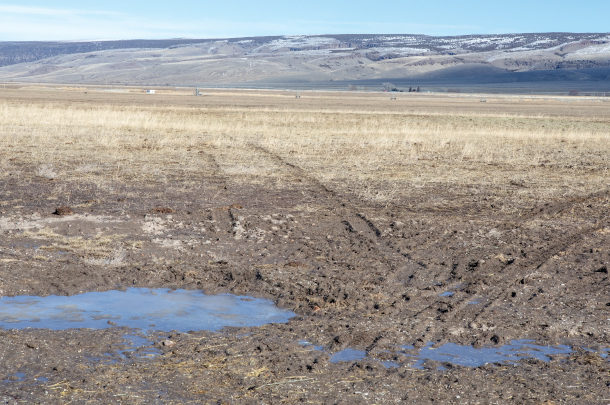This fall and winter has been very wet across most of the eastern U.S. In some areas, fields have been wet since August. In years like this, normal plans for dealing with mud may not be enough.
For instance, I recently had a beef producer from southern Illinois tell me he had moved cattle to the ridges in November, which is his last line of defense. In years past, getting cattle out of the muddy bottomland has solved the problem. But this year, they are making a muddy mess of the high ground too. He doesn’t dare put cattle in the bottom ground at this point, so he is out of places to go.
In the seed industry, we are being asked what to do with paddocks or fields that are already damaged. Whatever has happened so far cannot be changed, only evaluated and used as a learning opportunity. One tempting idea is to do nothing and let nature heal itself. This can work but works much better in soils that expand and contract for some reason, like freezing and thawing, or swelling when wet.
While there is no input cost to this method, this healing process can take years. In the meantime, production losses can be from 25 to 50 percent. To fully account for the cost of doing nothing, reduced production needs to be part of the calculation.
In the coming spring, you may feel the need to smooth out the rough fields. If you plan to drive equipment over the fields, some smoothing out is probably necessary. If the damage is in an area that will not see harvest equipment, it may not be absolutely necessary to smooth it out. From the plant’s point of view, smoothing out the field does not make the stand thicken any more quickly. But it makes a huge difference when spreading fertilizer or harvesting.
If smoothing is in order, the most popular choices are rolling or dragging a harrow. Neither choice is perfect. Rolling can cause more compaction if done when the soil is too wet, and dragging can tear out more plants, making a thin stand even thinner. If either approach is taken, it is probably worth the effort of broadcasting some seed first.
Other than time, adding seed is the only thing that will thicken the stand after damage. Red clover or grasses in the ryegrass family are good choices due to their exceptional seedling vigor. If you determine you really need more permanent grasses like brome, fescue or orchardgrass, broadcasting is not a good choice; you really should interseed with a no-till drill.
As mentioned above, the time the stand takes to recover on its own will likely be at least a year, and the danger of weed invasion goes up dramatically. If you don’t thicken the stand, you need to come up with a plan to compensate for forage loss.
If you have livestock in drylots now, keeping them there is best for your forage stands. Of course, this strategy only works if you have enough stored forage to last all winter. If you are concerned about having enough hay and had some fall grazing you didn’t get to due to weather, you can try to graze those areas if the ground is frozen or has firmed up a bit.
Another important step to take now is to look at your cropping plan for 2019. If there are fields scheduled to be rotated out or renovated in the spring, damaging them should not create much extra work if you were going to renovate that stand anyway. If you need another sacrifice area at this point, sacrifice the worst, not the best.
Looking forward, use the lessons learned dealing with this year’s wet conditions to figure out a plan tailor-made to your operation. Understand that the damage to wet soils comes from both soil compaction and plant thinning due to crown damage from either hoof or wheel traffic. When it comes to compaction, plants in the ryegrass family are among the best at growing in compacted soils. Plants that spread by rhizomes or stolons lessen traffic damage. In many cases, grasses that spread by rhizomes are those that can often be thought of as aggressive and undesirable. Examples would be smooth brome, quackgrass, bermudagrass, reed canarygrass and Kentucky bluegrass. Typically, these are not our favorite choices for forage, but they might be the best place to have livestock if things get too wet.
As you look at your whole operation, maybe there is a reason to have some smooth brome or bluegrass stands as a mud management strategy. When I was growing up, our heifer pasture was a solid stand of quackgrass. This 10-acre pasture had hundreds of bred heifers on it from November till May. By spring, it looked like a parking lot, but it was hayed in the summer giving 2 to 3 tons of hay and then regrew for the next round of heifers in the fall.
It was an amazing stand. You could count the weeds on one hand and, on the other hand, you could count the grass plants that were not quackgrass – nothing else could stand up under all that traffic and abuse.
Consider using some rhizomatous grass in your sacrifice area. In our case, I don’t think anyone had a grand plan to plant quackgrass. Rather, over many years, quackgrass was the only thing that could survive and, in the end, the plants and the management matched up.
Plan now to evaluate all of your fields in the summer and decide at that time where the animals will go in case of emergency. If you have some forage stands with strong sod, they might be good candidates to graze if conditions get wet. Even if you have only bunch grasses, remember: Older stands will hold up to traffic better than newer seedings.
Last, it is important to remember an area damaged this year will be more prone to damage next year. Soil compaction will influence water infiltration next year, and the weakened stand will not hold up as well to traffic. Decide now what you will do the next time you face similar conditions.
Will you sacrifice the same area again or will you allow it to recover and sacrifice another spot? There is no right or wrong answer, but having a plan in place ahead of time will pay dividends in reduced stress and lost time due to agonizing over what to do next. We will see wet falls again in the future; use the lessons learned this year to be better prepared next time. ![]()
PHOTO: Water standing in a field makes a muddy mess. Staff photo.

-
Chad Hale
- Research and Acquisitions Manager
- Western Forage Resources
- Email Chad Hale









